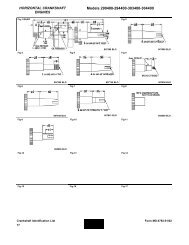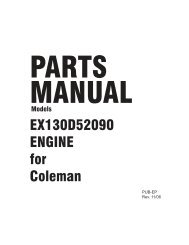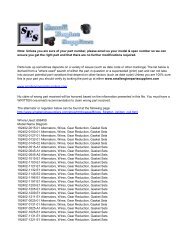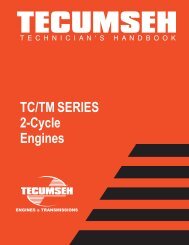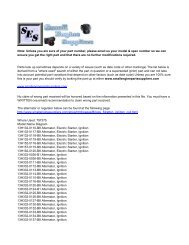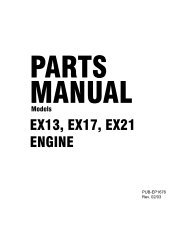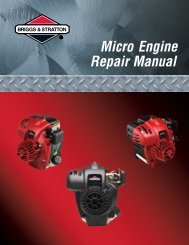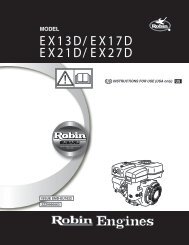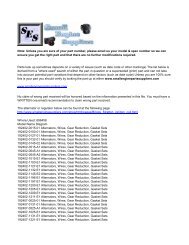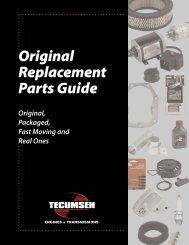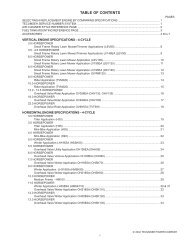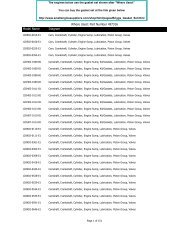3to 11hp 4-cycle l-head engines - Small Engine Suppliers
3to 11hp 4-cycle l-head engines - Small Engine Suppliers
3to 11hp 4-cycle l-head engines - Small Engine Suppliers
You also want an ePaper? Increase the reach of your titles
YUMPU automatically turns print PDFs into web optimized ePapers that Google loves.
The condenser acts as an electrical shock absorber to<br />
prevent arcing between the contact points as they open.<br />
Arcing will lower the voltage at the spark plug, as well as<br />
burn and pit the contact points. The condenser is a<br />
replaceable item (diag. 10).<br />
The spark plug is made up of two electrodes. The outside<br />
electrode is grounded and secured to the threaded sleeve.<br />
The center electrode is insulated with porcelain. The two<br />
are separated by an air gap which creates a resistance.<br />
A large voltage from the secondary arcs the air gap which<br />
causes a spark and ignites the air-fuel mixture in the<br />
cylinder (diag. 11).<br />
10<br />
11<br />
The contact points consist of an insulated, movable point<br />
that connects to the coil primary lead, and a stationary<br />
point that is grounded to the stator body. Spring tension<br />
holds the points together making a complete path for the<br />
primary circuit, and are opened by the action of the point<br />
arm which rests on the ignition cam. The contact points<br />
are a replaceable item (diag. 12).<br />
12<br />
The ignition cam is an oblong device which rotates with<br />
the crankshaft, and opens the points for firing the ignition<br />
system. It is important to check the ignition cam for<br />
roughness, if rough replace the cam. When inserting the<br />
ignition cam onto the crankshaft make sure that the side<br />
stamped "TOP", or the side that has an arrow on it faces<br />
the mechanic (diag. 13).<br />
NOTE: SOME IGNITION CAMS ARE MACHINED<br />
DIRECTLY ONTO THE CRANKSHAFT AND ARE NOT<br />
REPLACEABLE.<br />
13<br />
The stator plate is an aluminum fixture which houses<br />
the points, cam wiper, condenser, and has the laminations<br />
riveted to it. The laminations are strips of iron riveted<br />
together to form an iron core. Rust or debris in between<br />
the laminations will hamper the performance of the ignition<br />
system. If corrosion on the laminations is severe, the stator<br />
plate should be replaced (diag. 14).<br />
14<br />
The flywheel key locates the flywheel to the crankshaft<br />
in the proper position. If a flywheel key is sheared, or<br />
partially sheared, the engine will not start or be difficult<br />
to start (diag. 15).<br />
15<br />
65



